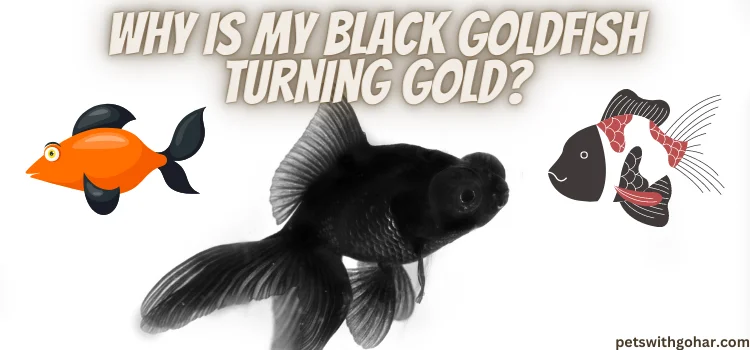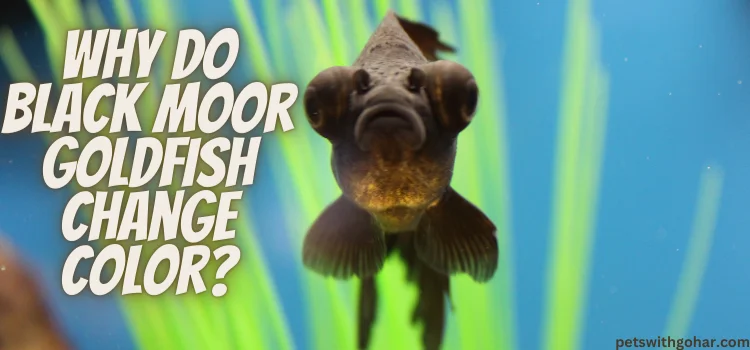Black Moor Goldfish can change color due to several factors, including genetic predisposition, environmental changes, diet, aging, and exposure to sunlight.
Most black moors are not genetically programmed to retain their black color throughout life and transition to gold or other colors as they mature.
Environmental factors such as water quality and temperature fluctuations can also stress your goldfish, triggering a color change.
Dietary factors, particularly foods rich in color-enhancing compounds like carotenoids, can also change color.
Finally, inadequate sunlight can cause these fish to lose their black color over time. It’s important to note that these color changes are typically normal and not a cause for concern unless other signs of illness accompany them.
Why Is My Black Goldfish Turning Gold?

Gold is one of the many possible colors a black moor goldfish can morph into. The primary reasons for this transformation often involve genetic factors, environmental changes, diet, age, and exposure to sunlight.
At the core of color changes lies a unique genetic predisposition. Most black moor goldfish are not genetically programmed to retain their black color throughout life. Instead, their genes instruct them to transition to gold or other colors as they age.
Environmental factors also play a significant role in these color changes. Water quality, for instance, can directly impact the color of your goldfish.
Poor water quality or substantial changes in water parameters like temperature and pH can stress your goldfish, potentially triggering a color change.
The diet of a black moor goldfish could influence its color as well. Foods enriched with color-enhancing ingredients like carotenoids can modify your fish’s color.
These compounds are commonly found in high-quality fish food and fresh fruits and vegetables.
Exposure to sunlight is vital for maintaining the black color in black moor goldfish. Lack of the sun can cause them to turn gold over time.
Why Is My Black Moor Turning Orange?
If you’ve noticed your black moor goldfish gradually changing color to orange, it’s essential to understand the reasons behind this transformation:
1. Diet: One common reason for this color change is diet-related. An inadequate diet lacking essential nutrients can lead to a loss of black pigmentation in black moor goldfish, revealing their underlying orange coloration. Ensure your fish have a well-balanced diet with high-quality goldfish pellets or flakes.
2. Age: As black moor goldfish age, it’s natural for their color to change. Young black moors may have predominantly black coloring, but some may develop orange patches or streaks as they mature.
3. Genetics: The genetic makeup of your black moor goldfish can play a significant role.orange coloration as they age.
4. Environmental Factors: Poor water quality, inadequate filtration, and overcrowded tanks can induce stress in goldfish, potentially causing color changes. Ensure your aquarium has proper filtration, regular water changes, and adequate space for your fish to thrive.
5. Illness: Sometimes, illness or disease can affect a black moor’s coloration.
In summary, black moor goldfish can turn orange due to diet, age, genetics, environment, or illness. To maintain their vibrant black coloration, provide them with a balanced diet, ideal living conditions, and attentive care. If you’re concerned about the color change, consult a veterinarian or experienced aquarist.
Similar to turning gold, A black moor goldfish may also change to an orange hue due to the same reasons: genetics, environment, diet, age, and sunlight exposure.
Genetically, Black moors often turn orange as they mature. This transition can start as early as four to six months old. It’s a natural process and generally not a cause for concern.
Environmental factors that stress fish, such as a rapid shift in temperature, can also result in a color change.
Fish, like many other animals, have physiological responses to environmental stressors. One such response in goldfish can be a color change.
Nutritionally, a diet rich in carotenoids found in foods like spirulina, shrimp, and certain vegetables can lead to an orange hue.
This color change may be more prominent in fish once black since the orange stands out against the dark background color.
Limited exposure to sunlight can cause black moor goldfish to turn orange. Sunlight helps retain the dark pigmentation; without it, the fish’s color may fade.
Why Do Goldfish Change Color From Black To Orange?

Goldfish are known for their ability to change color over time, and the transition from black to orange is common. Several factors can explain this intriguing phenomenon:
1. Genetics: Goldfish have a range of genetic variations that influence their coloration. Some goldfish, like the Black Moor, may start black but carry the genetic potential to develop orange coloring as they mature.
2. Age: As goldfish age, it’s normal for their color to evolve. Young goldfish may have darker colors that gradually shift as they age, revealing their actual, underlying coloration.
3. Diet: Diet plays a vital role in goldfish coloration. A diet rich in carotenoids, natural pigments found in foods like spirulina and certain vegetables, can enhance and maintain the orange or red hues in goldfish.
4. Environmental Factors: Water quality, tank size, and environmental conditions can impact a goldfish’s stress levels. Stress can affect their coloration, causing a color shift. Ensure your aquarium provides optimal living conditions to minimize stress.
5. Health and Well-being: The overall health of your goldfish can influence their color. Illness or nutritional deficiencies may lead to a fading or changing of colors. Regular health checks and proper nutrition are essential.
In summary, goldfish can change from black to orange due to genetics, age, diet, environmental factors, and overall health. This natural transition is a fascinating aspect of goldfish care. To maintain vibrant coloration, provide a balanced diet, maintain a stress-free environment, and ensure your goldfish’s well-being. If you notice drastic or concerning color changes, consult an experienced aquarist or veterinarian.
As detailed above, goldfish, including black moors, may transition from black to orange due to genetic and environmental factors.
The black moor goldfish’s color is often temporary, known as “baby black.” The fish may start life as a black goldfish, but as it matures and grows, its genes prompt a change to its adult color, typically orange or gold.
Inadequate lighting, poor water quality, temperature fluctuations, and diet can contribute to this transformation.
It’s important to remember that while these color changes can be surprising, they’re usually normal and not a cause for concern unless accompanied by other signs of illness.
Conclusion.
The transformation of a black moor goldfish from a deep, velvety black to a radiant orange or gold is a fascinating process driven by genetics, environmental conditions, diet, and exposure to sunlight. While it may initially cause worry for goldfish owners, understanding the reasons behind the color change helps demystify this phenomenon. As long as your fish seems healthy and active, the color change is usually not a cause for concern.
Frequently Asked Questions.
Why is my black goldfish changing color?
Black goldfish may change color for various reasons, such as genetics, environmental changes, diet, aging, or lack of adequate sunlight.
Why is my black moor goldfish turning white?
A black moor goldfish might turn white due to aging, a lack of proper nutrients, poor water quality, or insufficient light.
Why do goldfish change color over time?
Goldfish often change color due to genetic factors that dictate color changes as they mature. In addition, environmental conditions, dietary factors, and light exposure can affect coloration.
Is it normal for black goldfish to change color?
It’s normal for black goldfish, including black moor goldfish, to change color as they mature or respond to environmental changes, diet, or light exposure.
Why does goldfish color change?
Goldfish color can change due to genetics, environmental conditions, diet, and light exposure.
Do goldfish change from black to gold?
Yes, it’s not uncommon for black goldfish, like the black moor, to change to a gold color as they mature or respond to environmental, dietary, or light conditions.
Why is my black goldfish losing its color?
Your black goldfish might lose color due to aging, lacking essential nutrients, insufficient sunlight, or stressful water conditions.
How do you keep goldfish black?
To maintain the black color of your goldfish, provide a balanced diet, ensure good water quality, avoid sudden environmental changes, and provide ample lighting. However, it’s important to understand that if your fish is genetically programmed to change color, there’s little you can do to prevent this natural process.

